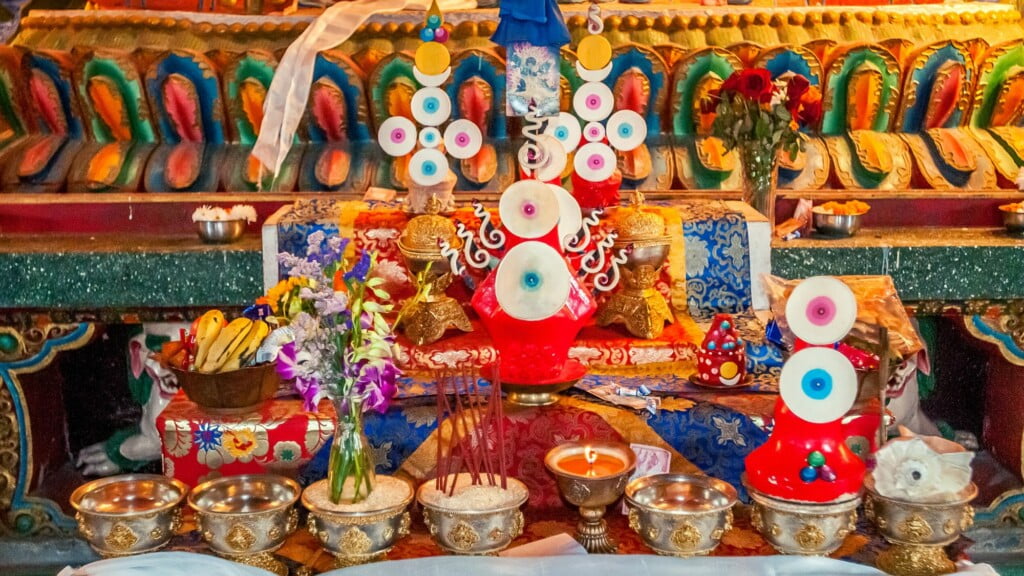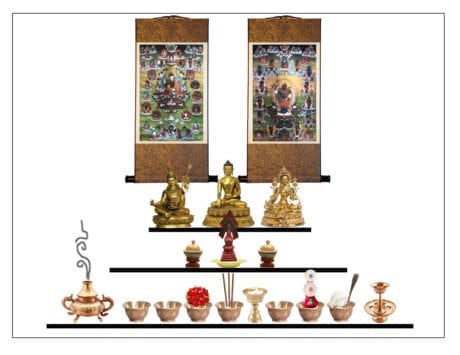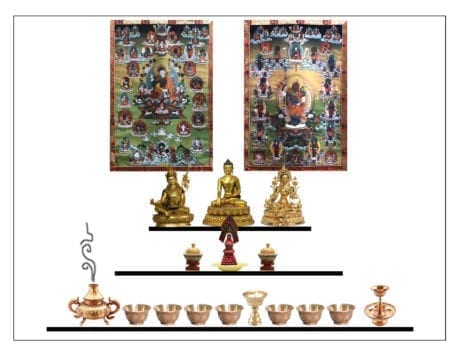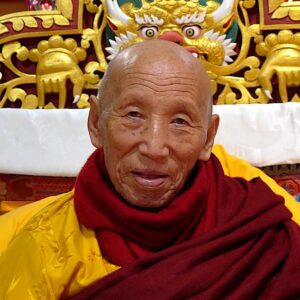Tukdrup Barché Kunsel Shrine Diagram
Many students ask questions about how to set up a proper Tukdrub Barché Kunsel shrine for group practice or at home. Phakchok Rinpoche requested his artist to prepare detailed diagrams that we may follow.
In addition, Rinpoche recently shared some specific and direct instructions for shrine set-up. We offer these instructions below, corresponding to the order of the diagram.
Thangkas
We should hang two thangkas behind the shrine. As you see in the photo, on the left (facing you) we hang the Tukdrup Barché Kunsel 12 Manifestations of Guru Rinpoche, Dispeller of Obstacles thangka.
And on the right (facing you) we hang the Tukdrub Yishyin Norbu (or Sampa Lhündrup, The Spontaneous Fulfiller of All Wishes). Students may invite these thangkas through Akara Collection.
Tukdrup Barché Kunsel Shrine Statues
Students should set up their shrine with at least two statues. We use the support of a Śākyamuni Buddha and a second support of a Guru Rinpoche statue. In addition, if the student is doing another practice, such as Tārā, then she would add that deity statue.
Note that we place the Śākyamuni Buddha statue in the center.
Tukdrup Barché Kunsel Shrine Offerings
Next, we see a second row of offerings below the statue in the diagram.
Inner offerings on the Tukdrup Barché Kunsel Shrine
Please note: Beginner practitioners do not need these inner offerings.
Mahāyoga practitioners should offer amrita, rakta and balingta (torma) offerings as shown in the diagram. Amrita purifies anger, rakta purifies desire and torma purifies ignorance. Also, offering these inner substances utilizes skillful means, helping us to realize non-dualistic wisdom and the primordial purity of all phenomena.
In addition, as Vajrayāna practitioners, these students may add the sang (cleansing smoke) offering on the shrine left as shown. And, on the right, we place the Mahalaka protector torma offering.
Outer Offerings: Seven Offering Bowls and Light
On the first level, we display seven offering bowls and a light offering. Here, we can offer in two ways:
- We can fill these bowls with pure water, as shown in the diagram above.
- Alternatively, we offer the traditional eight Indian offerings illustrated in the diagram at the beginning of the article. Here, we use the same seven bowls, but the contents differ. These offerings are:
- pure drinking water
- bathing water
- flowers
- incense (three sticks representing the three jewels)
- light (note: we offer this separately, not in a bowl)
- scented water (perfume)
- torma or food
- music (in our tradition, we use a white conch shell)
When we offer substances other than water, we place them on a bed of clean rice, semi-precious stones, or white sand. Traditionally, we carefully set the shrine with the bowls only a rice-grain width apart.












Responses
As a practitioner faces the shrine, on which side of the torma is the amrita cup placed and which the rakta?
Hi Ellen,
As you face the shrine, the amrita would be on your left and the rakta would be on your right. (Please note that in many texts the directions are given from the point of view of the central deity!)